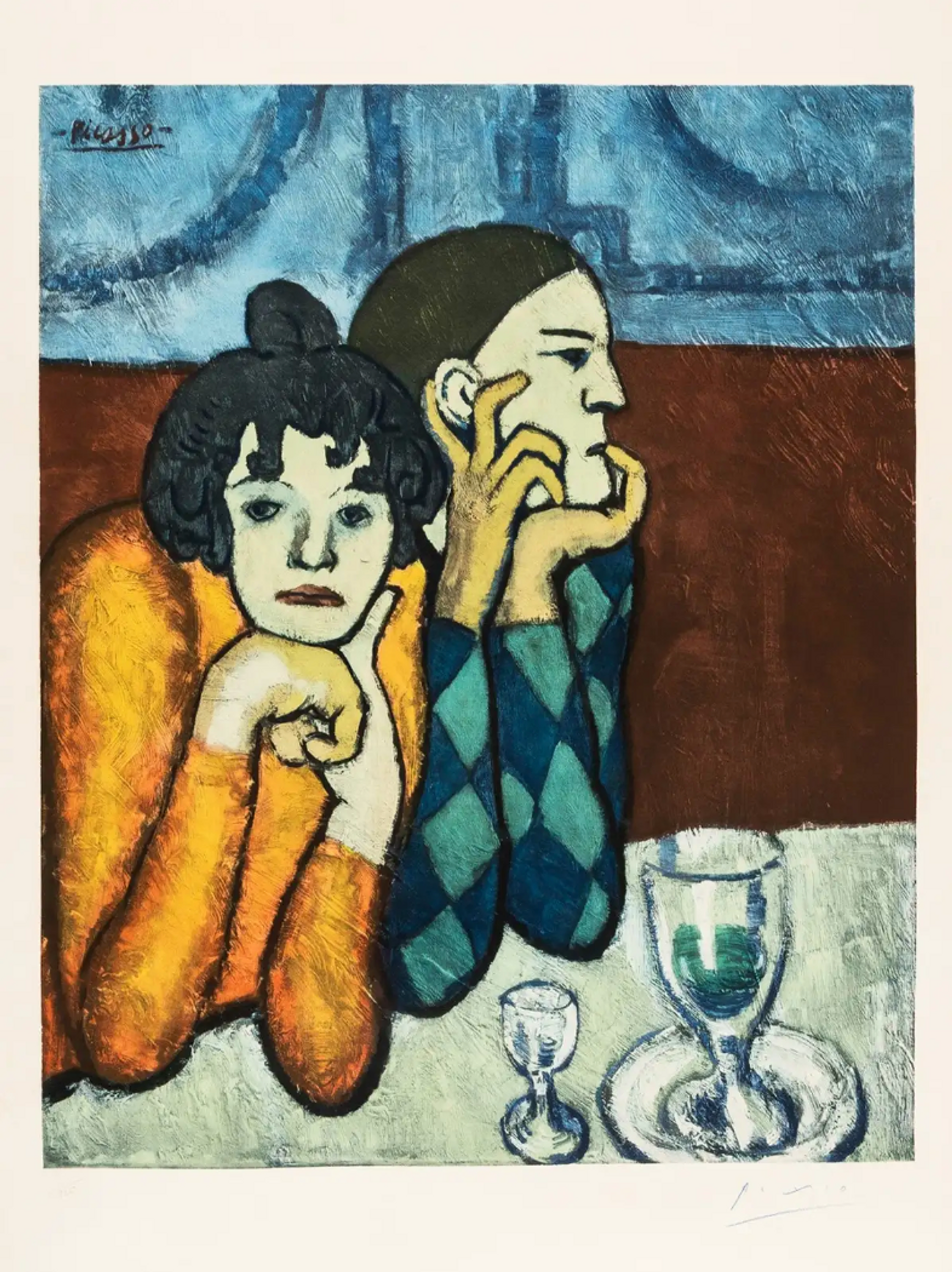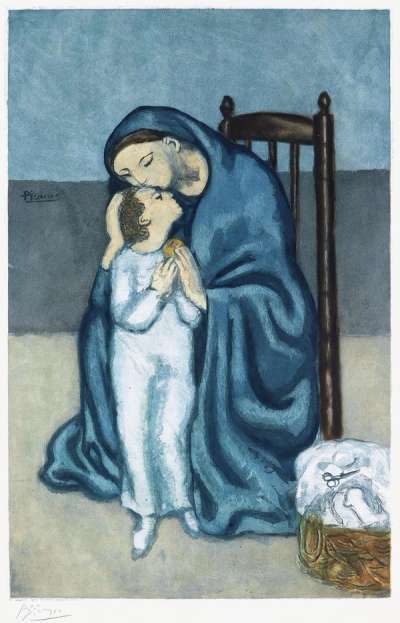The Influence of the Spanish Civil War on Pablo Picasso’s Art

 Guernica © Pablo Picasso 1937
Guernica © Pablo Picasso 1937
Pablo Picasso
155 works
Key Takeaways
Pablo Picasso’s art was deeply influenced by the Spanish Civil War (1936–1939), reflecting his opposition to violence and fascism. The conflict, including the 1937 bombing of Guernica, inspired his masterpiece Guernica, which remains an enduring anti-war symbol. Created for the Paris International Exposition, the painting uses stark monochromatic tones and symbolic imagery, such as the suffering horse and grieving mother, to convey the horrors of war. Picasso’s political awakening during this period saw him use his art for activism, as seen in works like The Weeping Woman and Dream and Lie Of Franco. These artworks solidified Picasso’s legacy as an advocate for justice, influencing the visual language of protest.
Pablo Picasso, one of the most influential artists of the 20th century, created a body of work that reflected social and political discourse. The Spanish Civil War (1936–1939) deeply impacted his work. Witnessing the devastation of his homeland, including the bombing of Guernica in 1937, Picasso channeled the horrors of war into iconic, symbolic works that condemned violence and injustice.
The Context of the Spanish Civil War and Picasso’s Connection to Spain
The Spanish Civil War (1936–1939) was a pivotal conflict between the Republicans, who supported the democratically elected government, and the Nationalists, led by General Francisco Franco. The war resulted in significant civilian suffering, with widespread displacement. The Nationalist victory established a fascist dictatorship under Franco, marking a critical point in the rise of fascism in Europe.
Picasso, born in Málaga, Spain, in 1881, spent much of his adult life in France but maintained an emotional connection to his home country. The turmoil in Spain prompted him to use his art to comment on trauma inflicted on innocent Spanish civilians.
Guernica – Picasso’s Masterpiece of Protest
The Bombing of Guernica and Its Impact on Picasso
On April 26, 1937, the Basque town of Guernica was subjected to a devastating assault by Nazi German and Italian fascist forces. The attack, carried out under the direction of General Francisco Franco’s Nationalist forces, marked one of the first instances of modern warfare systematically targeting civilians to instil fear. Over the course of three hours, bombing reduced much of the town to rubble, killing and displacing hundreds of residents. The event became a symbol of the human cost of war and is often regarded as a precursor to the "total war" tactics later used against civilian populations.
For Picasso, the news of Guernica’s destruction struck a personal chord. Living in Paris at the time, he was commissioned to create a mural for the Spanish Pavilion at the 1937 Paris International Exposition. Originally intending to explore a different theme, Picasso was deeply affected by the reports and images of the bombing. In response, he created Guernica, a monumental painting that captured the tragedy inflicted by the war.
Symbolism and Imagery in Guernica
Guernica is one of the most iconic anti-war artworks in art history, with its haunting imagery conveying the intricacies of human suffering. At the centre of the composition, a horse writhes in agony, its body pierced and twisted, viscerally symbolising the physical pain of the victims. To its left, a bull looms large—a symbol of strength and endurance. Surrounding these central figures, fragmented human forms, including a grieving mother clutching her dead child, reflect the trauma and helplessness of civilians.
Picasso’s use of monochromatic tones heightens the painting’s stark emotional intensity, evoking the newspaper photographs that first brought the event to public attention. His distortion of figures mirrors the chaos and destruction of war, creating a cluttered, overwhelming sense of disarray. A dismembered arm clutching a broken sword and a lightbulb in an all-seeing eye hint at the unrelenting plight of humanity and critical thought against fascism.
 Image © Tate / Weeping Woman © Pablo Picasso 1937
Image © Tate / Weeping Woman © Pablo Picasso 1937Picasso’s Shift to Political Art During and After the War
Picasso’s Role as an Artist in Exile and His Political Awakening
The Spanish Civil War marked a pivotal moment in Pablo Picasso’s career, transforming him from an artist focused primarily on personal and stylistic exploration into a critic of political oppression. Although Picasso had been living in Paris since 1904, the conflict in Spain deepened his emotional connection to his heritage and prompted him to use his art as a platform for protest. The atrocities of the war, coupled with the rise of fascism under Francisco Franco, shaped Picasso’s outlook, awakening a stronger sense of his agency for social change.
From this period onward, Picasso became increasingly direct in his opposition to fascism. His appointment as honorary director of the Prado Museum in Madrid in 1936 solidified his role as an ambassador for Spain’s socio-political resistance. Living in exile, Picasso used his international platform to align his art with anti-fascist ideals, creating works that condemned the brutality of war. This political awakening reinforced his public persona as an advocate for justice.
Works Reflecting War, Loss, and Resistance Beyond Guernica
While Guernica remains Picasso’s most famous response to the Spanish Civil War, it was not his only work to address war, loss, and resistance. Among his most poignant creations from this period is The Weeping Woman (1937), a series of paintings and sketches that provides a more intimate look at the grieving mother figure featured in Guernica. The woman in the painting references traditional depictions of the Virgin Mary mourning the death of Jesus Christ, a common theme in Baroque Spanish religious art, presenting her as a universal symbol of mourning. The central subject captures the emotional devastation of war through her distorted, tear-fractured face, serving as a powerful metaphor for the enduring agony of its victims.
Another notable work is Dream And Lie Of Franco (1937), a series of two sheets of prints, each containing nine images arranged in three rows, together forming an eighteen-scene narrative. The series portrays Franco as a monstrous figure, symbolising his destructive impact on Spain during the Spanish Civil War. Created as propaganda to support the Republican government, the prints were sold as postcards to raise funds. The final scenes, added after the bombing of Guernica, connect the series to Picasso’s iconic mural, amplifying its anti-war message. Through sharp symbolism and satirical imagery, the series reflects Picasso’s commitment to resistance.
These works, like Guernica, echo the emotional intensity and protest themes that defined Picasso’s response to the Spanish Civil War. They illustrate the evolution of his art from personal expression to a powerful vehicle for political commentary.
The Legacy of Picasso’s War-Inspired Art
How Guernica Became a Universal Symbol of Anti-War Sentiment
Going beyond its original purpose to comment on the 1937 event, Guernica has become universal anti-war symbol. Its monumental scale, at over 11 feet tall and 25 feet wide, demands a confronting engagement with the devastation it depicts. Guernica has been exhibited across the world, and is an enduring testament to art as a force for political protest.
By the mid-20th century, Guernica had firmly established its position as a universal emblem of universal suffering and resistance. Its stark depiction of civilians resonated during subsequent conflicts, including World War II and the Vietnam War. The painting’s return to Spain in 1981, after the end of Franco’s dictatorship, marked a symbolic moment of reconciliation and renewed commitment to peace. Today, housed in Madrid’s Museo Reina Sofía, Guernica continues to inspire debate, reflection, and activism.
Picasso’s Influence on Political Art and Modern Protest Art
Picasso’s response to the Spanish Civil War set a new standard for how artists could engage with political and social issues through their work. Guernica and his other war-inspired works demonstrated that art could provide a voice for victims and an alternative perspective against fascist regimes. Guernica has become a cornerstone in the broader discourse of protest art, demonstrating how creativity can serve as a tool for resistance and advocacy. Its influence can be seen in movements ranging from the Civil Rights murals of the 1960s to contemporary works addressing issues like climate change.
Beyond his arresting Guernica, Picasso’s opposition to fascism helped shape his legacy as an artist committed to justice and human rights. Today, works by artists like Ai Weiwei and Banksy correspond with Picasso's example, as they use their platforms to boldly confront injustices. Picasso’s legacy endures as a reminder of the role art can play in challenging oppression.














